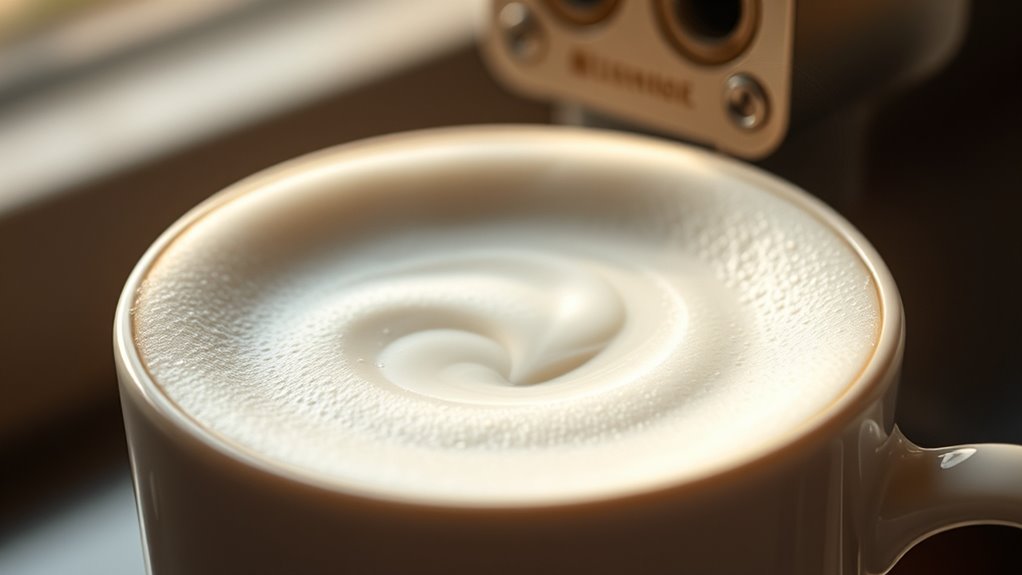Milk frothing works by carefully mixing air, heat, and milk proteins to create a smooth, velvety foam that enhances flavor and texture. When you steam milk to the right temperature, tiny air bubbles are incorporated, stabilized by proteins and fats, forming microbubbles that make the foam rich and stable. Controlling heat and technique guarantees perfect froth every time—stick around to discover how to master each step seamlessly.
Key Takeaways
- Milk frothing involves air incorporation and protein breakdown to create a smooth, velvety foam.
- Proper temperature (140°F–150°F) stabilizes microbubbles, ensuring stable, glossy foam.
- Fats and proteins in milk stabilize tiny bubbles, affecting foam texture and longevity.
- Introducing air gradually forms microbubbles that increase foam volume and creaminess.
- Choosing the right milk type influences froth richness, stability, and overall texture.
What Is Milk Frothing and Why Is It Important?
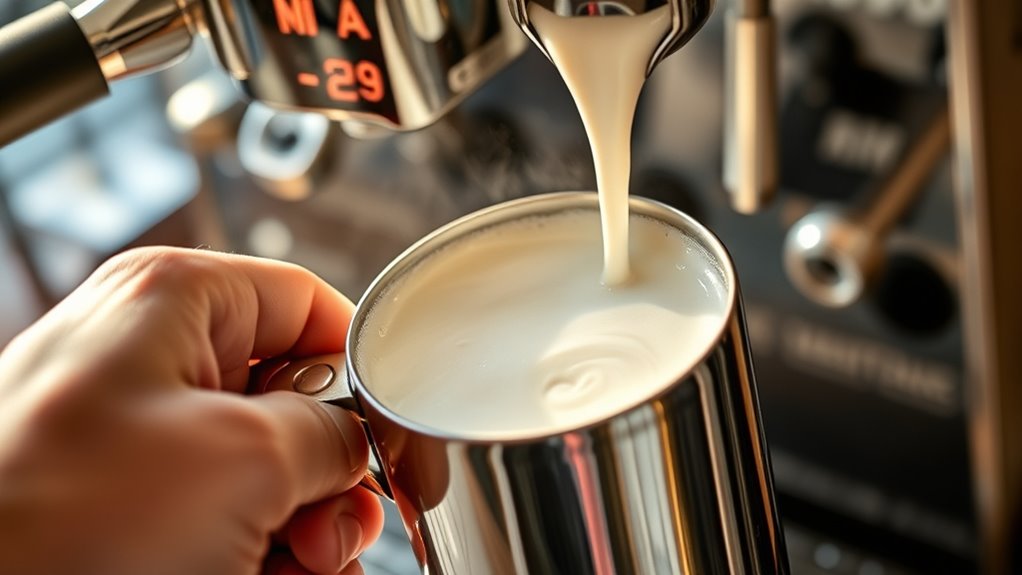
Have you ever wondered why perfectly frothed milk makes your coffee taste so much better? It all comes down to milk composition and frothing techniques. Milk is made up of water, fats, proteins, and carbohydrates. When you froth milk, the goal is to introduce air and break down fat globules and proteins, creating a creamy, velvety foam. Proper frothing techniques guarantee you incorporate just the right amount of air and achieve a smooth texture. This foam not only enhances the flavor but also creates a luxurious mouthfeel. The science behind milk frothing involves stabilizing tiny bubbles, which gives your coffee that rich, inviting appearance. Mastering these basics makes a noticeable difference in the quality of your coffee experience.
The Role of Temperature in Milk Frothing
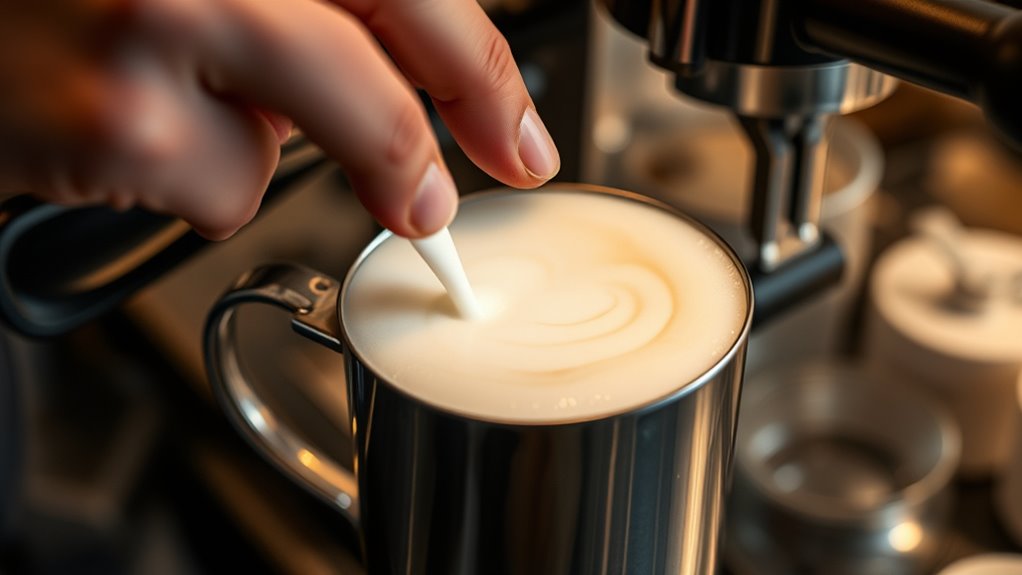
Temperature plays a vital role in achieving the perfect milk froth. If the milk is too cold, it won’t create enough foam, and if it’s too hot, the foam can become unstable or collapse. To get the best foam stability, aim for the ideal milk temperature, usually between 140°F and 150°F. Here’s what happens at different temperatures:
- Cold milk (below 130°F): Creates dense, slow-forming foam with poor stability.
- Perfect range (140°F–150°F): Produces smooth, glossy foam with excellent foam stability.
- Overheated milk (above 160°F): Causes foam to break down quickly and affects flavor.
Keeping the milk within the right temperature range ensures your froth is creamy, stable, and perfect for your coffee. Proper temperature control also prevents the foam from breaking down, ensuring a longer-lasting froth.
How Air and Milk Interact to Create Foam
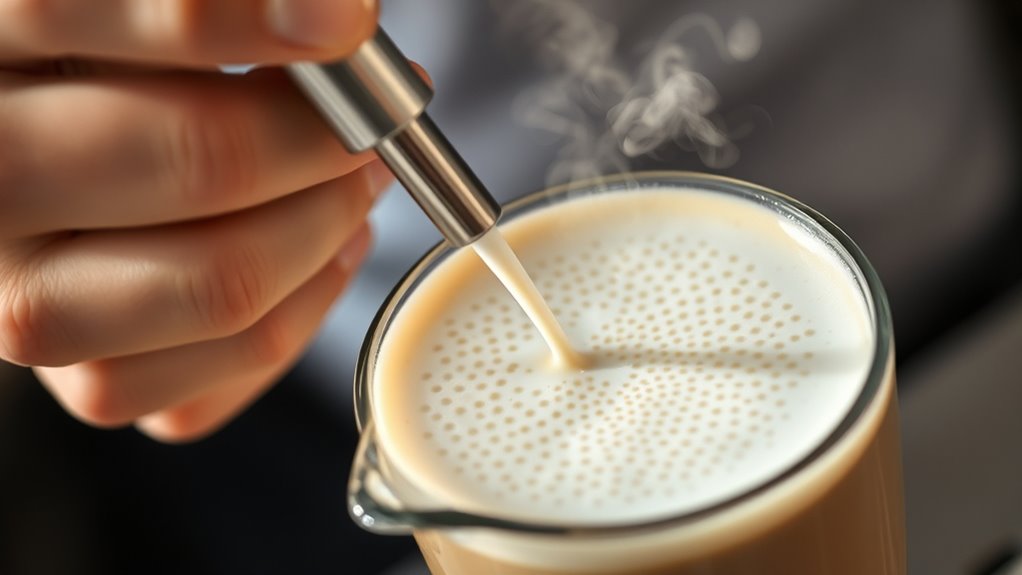
When you introduce air into milk during frothing, the interaction between the air bubbles and the liquid creates the foam you desire. As you whisk, microbubbles form, stabilized by surface tension, which keeps the foam smooth and creamy. The air disperses into tiny bubbles, increasing the foam’s volume and texture. The balance between air incorporation and milk’s properties determines foam quality. Proper technique ensures a steady stream of microbubbles, resulting in dense, velvety foam. Additionally, understanding AI’s role in cybersecurity can help protect your devices from disruptions during the frothing process. Here’s a quick overview:
| Aspect | Effect | Importance |
|---|---|---|
| Microbubbles formation | Creates small, stable bubbles | Key to smooth foam |
| Surface tension | Holds bubbles together | Maintains foam structure |
| Air incorporation | Adds volume and texture | Defines foam consistency |
| Milk properties | Affects bubble stability and size | Ensures ideal frothing results |
Different Types of Milk and Their Frothing Qualities
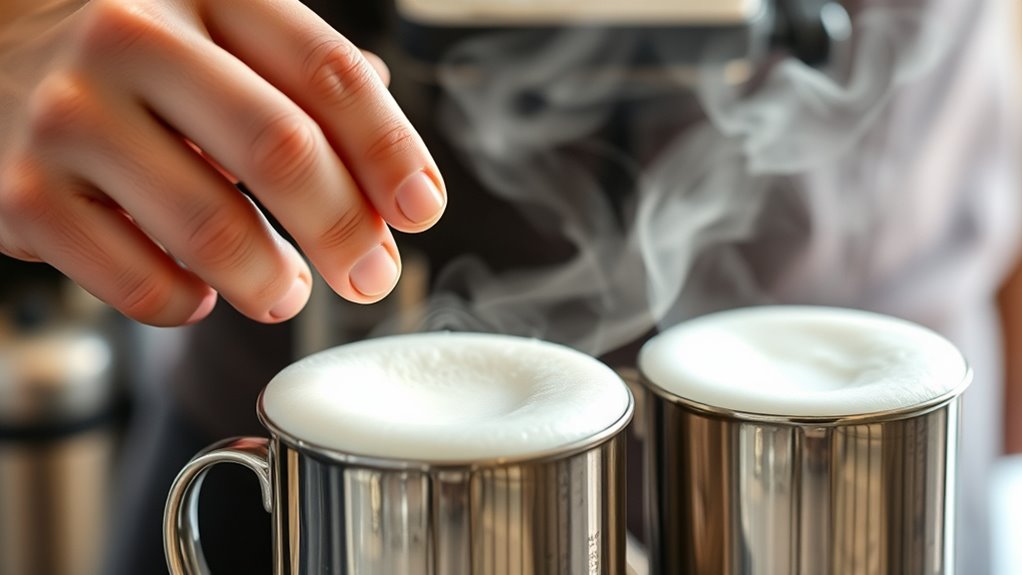
The type of milk you choose considerably impacts the quality of your froth. Dairy and plant-based options differ in milk composition, affecting how well they froth. Dairy milk typically produces richer, creamier foam because of its higher fat and protein content. Plant-based milks, like almond or soy, vary widely; some froth easily, while others struggle due to lower protein levels. To visualize this:
Choosing the right milk, dairy or plant-based, directly impacts the richness and froth quality of your coffee.
- Whole dairy milk creates dense, velvety foam.
- Skim dairy milk froths lighter but with more volume.
- Plant-based milks may require adjustments for better frothing, with soy or oat milk often performing well.
Your choice influences not just taste but also frothing quality, so understanding milk composition helps you pick the best option for your perfect froth. Additionally, high-quality milk can further improve frothing results by providing the ideal balance of proteins and fats.
Tips for Achieving Perfect Froth Every Time

Achieving perfect froth every time requires attention to a few key techniques that guarantee consistent results. First, focus on creating ideal milk texture by steaming milk to around 150°F (65°C), which helps produce smooth, velvety foam. Use a steady, controlled motion with your frother or steam wand to incorporate air gradually, ensuring the froth has good froth stability. Avoid over-aerating, which causes large bubbles and weak foam, or under-aerating, resulting in flat milk. Keep the milk pitcher at an angle and position the wand just below the surface for *superlative* microfoam. Consistently monitoring temperature and technique helps you develop a reliable feel for perfect milk texture and froth stability, making every cup beautifully topped. Incorporating crochet techniques can also inspire creative presentation ideas for latte art and decorative foam designs.
Frequently Asked Questions
How Does Milk Fat Content Affect Frothing Quality?
Higher milk fat improves frothing quality because it creates a creamier, more stable foam. Milk with lower fat content produces less rich foam that tends to be less stable and more prone to collapsing. When you choose milk with appropriate fat levels, you’ll notice a smoother, creamier froth that holds its shape longer. So, for better frothing quality, opt for milk with higher fat content, like whole milk.
Can Non-Dairy Milk Alternatives Produce Similar Foam?
Yes, plant-based alternatives can produce foam, but their foam stability varies. You might find soy, oat, or cashew milk create richer, more stable foam, while almond or coconut may struggle to hold air. To improve foam stability, heat the plant-based milk properly and use a frothing wand or steam wand. Experimenting with different brands and formulations helps you discover which alternatives give you the best foam for your coffee drinks.
What Is the Ideal Frothing Duration for Perfect Texture?
You should froth milk for about 20-30 seconds to achieve ideal frosting temperature and foam stability. Keep an eye on the milk as it warms up, aiming for around 140°F (60°C). This duration helps create a creamy, velvety texture with good foam stability. Over-frothing can cause the milk to become too hot or thin, while under-frothing might result in weak foam. Perfect timing guarantees the best froth quality.
How Do Different Frothing Tools Impact Foam Consistency?
Imagine you’re sculpting with different tools—each impacts your masterpiece. Similarly, your frothing tools influence foam consistency; a steam wand creates silky, fine bubbles, while a hand pump might generate denser foam. Your choice affects the final texture, so maintaining your tools guarantees ideal performance. Experiment with various frothing techniques and keep your tools clean to consistently craft perfect, velvety milk foam that elevates your coffee experience.
Does Milk Freshness Influence the Frothing Process?
Yes, milk freshness markedly impacts the frothing process. When milk is fresh, it creates richer, creamier foam due to ideal protein and fat content. Milk spoilage or expired milk, indicated by sour smell or curdled texture, won’t froth well and produces weak, unstable foam. Always check freshness indicators like smell and appearance before frothing to guarantee the best foam quality and flavor for your coffee.
Conclusion
Now that you understand the science behind milk frothing, you can confidently create your perfect cup. Imagine trying a latte at home, with rich, velvety foam on top—just like your favorite café. By controlling temperature, air, and milk type, you’ll master frothing every time. So go ahead, experiment, and enjoy crafting beautiful, delicious drinks that impress friends and satisfy your coffee cravings. Your barista skills are just a froth away!
